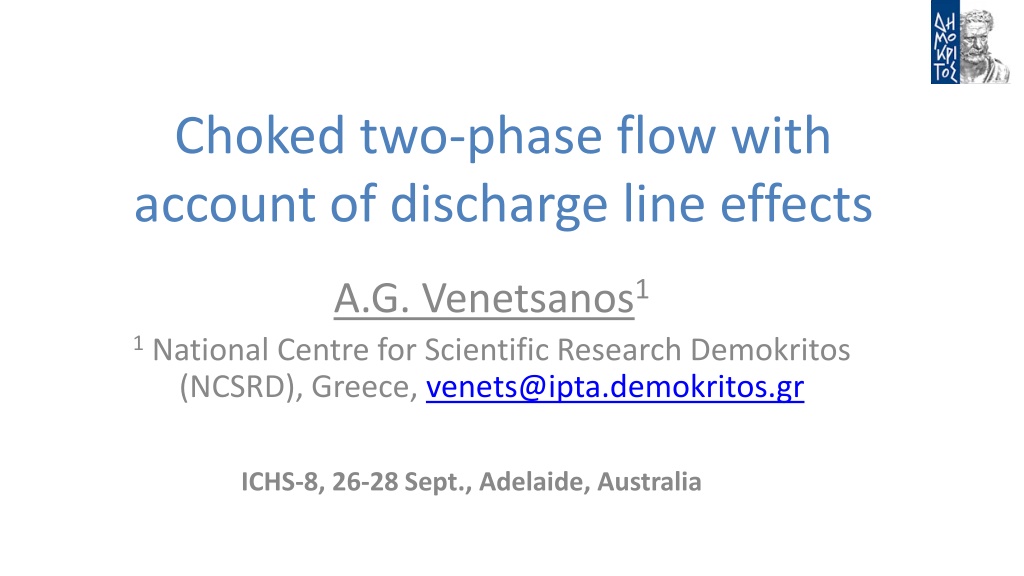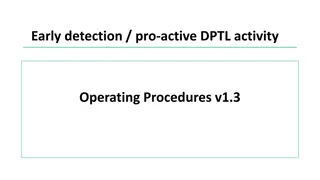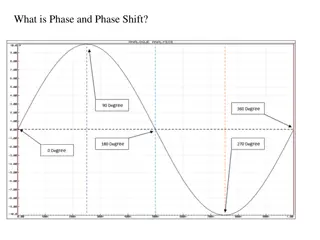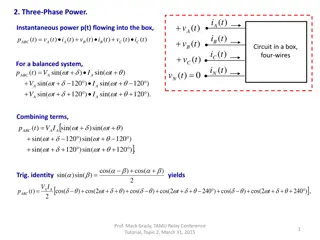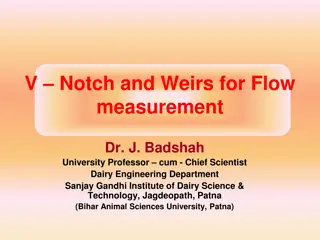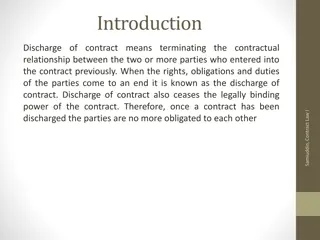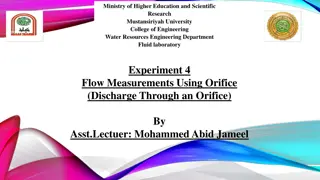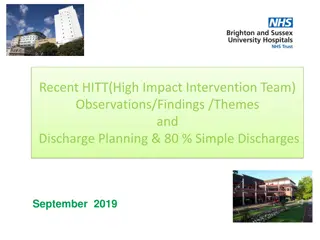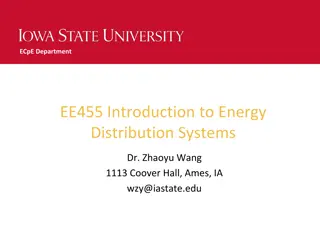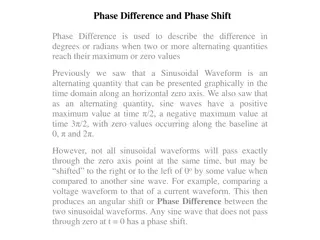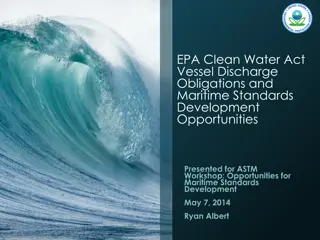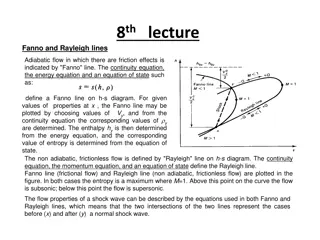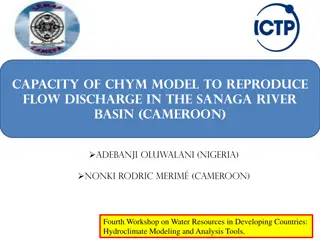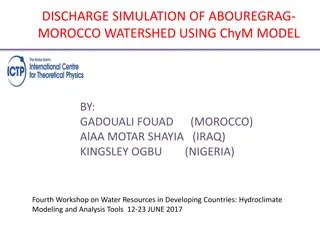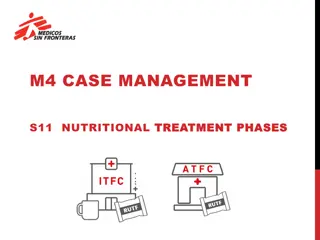Choked Two-Phase Flow with Account of Discharge Line Effects
This study delves into the intricate dynamics of choked two-phase flow, emphasizing the significance of accounting for discharge line effects in predicting source exit conditions for various discharge scenarios. The research encompasses mathematical formulations, numerical methods, and rigorous testing against experimental data to enhance the accuracy and reliability of engineering tools tailored for two-phase discharge systems.
Download Presentation

Please find below an Image/Link to download the presentation.
The content on the website is provided AS IS for your information and personal use only. It may not be sold, licensed, or shared on other websites without obtaining consent from the author. Download presentation by click this link. If you encounter any issues during the download, it is possible that the publisher has removed the file from their server.
E N D
Presentation Transcript
Choked two-phase flow with account of discharge line effects A.G. Venetsanos1 1National Centre for Scientific Research Demokritos (NCSRD), Greece, venets@ipta.demokritos.gr ICHS-8, 26-28 Sept., Adelaide, Australia
Contents Background / Scope Mathematical formulation Numerical methods Results Conclusions and future work ICHS-8, 26-28 Sept., Adelaide, Australia
Background / Scope Background Need for accurate prediction of source exit conditions for two-phase discharge scenarios Scope Development of an engineering tool for two-phase discharge Account for discharge line friction and cross sectional area change Steady state + adiabatic line conditions Implement and test different flash models against experiments ICHS-8, 26-28 Sept., Adelaide, Australia
Mathematical formulation Mass conservation = ( ) A z A Momentum conservation = (Re) f f GD = Re Energy conservation (adiabatic) ICHS-8, 26-28 Sept., Adelaide, Australia
Mathematical formulation (Physical properties / Independent variables) Single phase flow (T, P, G) = , , h v s = ( , ) T P HEM two-phase model (x, P, G) ( ) = + ( ) P 1 ( ) P x x VS LS HRM two-phase model (x, P, G, TL) = ( ) + ( ) P 1 ( , ) x x T P VS LM L DEM two-phase model (x, y, P, G, TL) ( ) ( ) = + + ( ) P ( ) P 1 ( , ) x y x y T P VS LS LM L ICHS-8, 26-28 Sept., Adelaide, Australia
Mathematical formulation (HRM) Vapor phase generation Relaxation time for Water Downar-Zapolski et al., The non-equilibrium relaxation model for one-dimensional flashing liquid flow. Int. J. Multiphase Flow 22 (1996) 473 483 ICHS-8, 26-28 Sept., Adelaide, Australia
Mathematical formulation (DEM) Total stable phase generation If P > Ponset Metastable phase change Water coefficients De Lorenzo et al. Benchmark of Delayed Equilibrium Model (DEM) and classic two-phase critical flow models against experimental data, Int. J. of Multiphase flow, 92 (2017) 112-130 ICHS-8, 26-28 Sept., Adelaide, Australia
Numerical methods Discretization Line discretized with adequate number of z=z2-z1elements Equations integrated over z Discretization scheme needed for terms that cannot be directly integrated Downstream advancement G2from continuity Iterate over P2in the range [Pback, P1] Solve energy and phase generation (may be iterative procedure) Exit if momentum is satisfied Exit if no solution is found ICHS-8, 26-28 Sept., Adelaide, Australia
Numerical methods PIF Algorithm for choked flow calculation Iterate over Pinlet Find other inlet conditions and Ginletby isentropic expansion from P0to Pinlet Perform downstream advancement to end of line If end of line is reached (G is possible) => decrease Pinlet(increase MFR) If end of line is not reached (G is impossible) => increase Pinlet(decrease MFR) ICHS-8, 26-28 Sept., Adelaide, Australia
Results Super Moby Dick water experiments (1980)* Case: P0= 20 bar, T0= 212.3 C Physical properties: IAPWS Formulation 1995 MFRHEM= 3.33 kg/s MFRHRM= 3.56 kg/s MFRDEM= 5.19 kg/s ICHS-8, 26-28 Sept., Adelaide, Australia *Jeandey et al., Report TT-163, (1981) CEA, Grenoble.
Results Dewar Line 1: D = 10.2 cm, L = 10 m Transition valve Line 2: D = 15.2 cm, L = 30 m NASA LH2experiments (1984)* Test-6: P0= 6.9 bar, T0= TSAT= 29.07 K MFRexp= 11.5 kg/s Physical properties: Leachman et al. (2009) MFRHEM= 1.98 * MFRexp ICHS-8, 26-28 Sept., Adelaide, Australia *Witcofski and Chirivella, IJHE 9 (1984) 425 435
Results Road Tanker D = 26.3 mm, L = 21.6 m HSE LH2experiments (1984)* P0= 2.0 bar, T0= TSAT= 22.91 K MFRexp= 0.07 kg/s Physical properties: Leachman et al. (2009) MFRHEM= 6 * MFRexp ICHS-8, 26-28 Sept., Adelaide, Australia *Hooker et al., ICHS-4, San Francisco, 2011
Conclusions and future work Conclusions Tool is able to predict choked and non-choked flow and axial distribution of all properties along discharge line Water validation: HRM and DEM: Predicted pressure and void fraction distribution follow experimental trends HEM: Too fast increase of void fraction. Exit void fraction close to HRM and DEM LH2 validation (only HEM) Large to very large discrepancy between predicted and experimental MFR !!! Future work Validate against PRESLHY project experiments from HSE and PS/KIT Develop HRM and/or DEM for hydrogen is needed Implement / validate other flashing models Include non-adiabatic conditions ICHS-8, 26-28 Sept., Adelaide, Australia
Thank You The research leading to these results was financially supported by the PRESLHY project, which has received funding from the Fuel Cells and Hydrogen 2 Joint Undertaking under the European Union s Horizon 2020 research and innovation program under grant agreement No 779613. ICHS-8, 26-28 Sept., Adelaide, Australia
